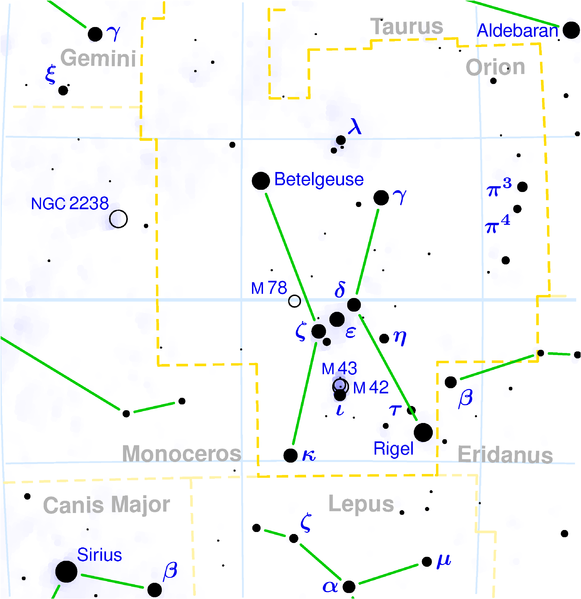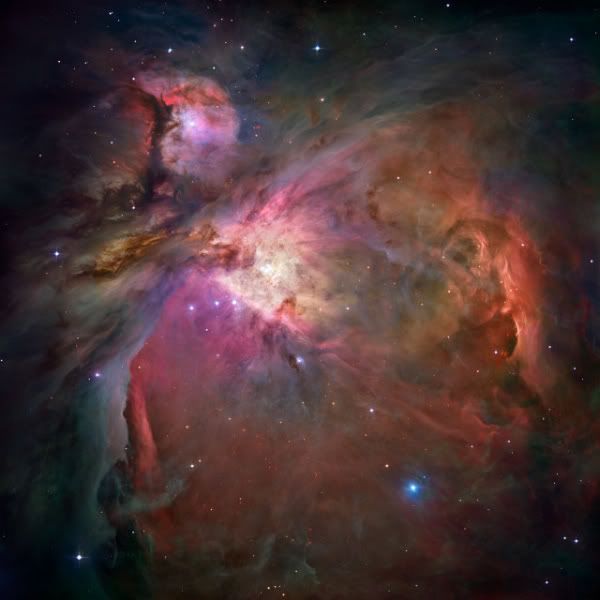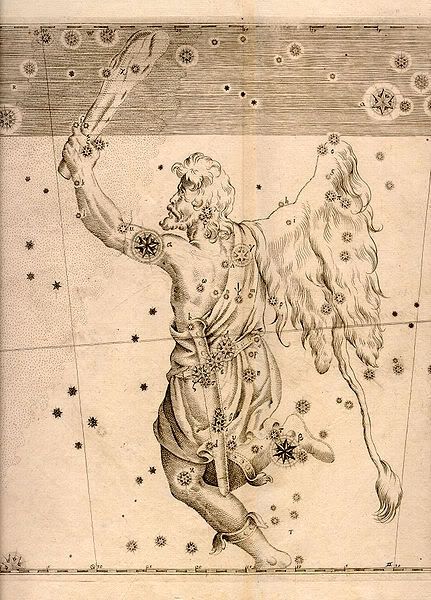The Constellation of Orion
(midnight. – promoted by ek hornbeck)
| StarDate: -314155.78 |
I've seen things you people wouldn't believe.
Attack ships on fire off the shoulder of Orion.
I watched C-beams glitter in the dark near the Tannhäuser Gate.
All those moments will be lost in time, like tears in rain…
Roy Batty.
Blade Runner, 1982
|
|
|
|
|
Orion, The Hunter, is a famous, easily recognizeable constellation located along the celestial equator which is visible from both the northern and southern hemispheres. In the northern hemisphere it is a winter constellation, visible in the night sky from November through February. The constellation contains 6 of the top 100 brightest stars in the sky.
An Ankle, a Knee, a Shoulder, and an Armpit
|
Betelgeuse, (? Ori; ? Orionis; Alpha Orionis [#11 AM: 0.2 to 1.5 var]): Betelgeuse is the red supergiant star at the upper-left in the picture. It has a mass of about 20 solar masses and a diameter perhaps 1000 times that of the Sun\u2014it
would reach out to beyond the orbit of Mars. It is estimated to be 640 light years away and about 8.5 million years old. Betelgeuse is a likely candidate for a Supernova event given its large mass and it is expected that that will happen soon, within a
millenia, if it hasn’t happened already.
Rigel (? Ori; ? Orionis; Beta Orionis [#7 Apparent
Magnitude: 0.12]): Rigel is the blue-white star at the lower right of the picture on the right. It is a blue supergiant seventeen times the mass of the sun. Rigel
is the brightest (~40,000 times the luminosity of the sun) star in our local region of the Milky Way at approximately 770 light years distance.
Bellatrix (? Ori; ? Orionis; gamma Orionis [#26 AM: 1.64]): Bellatrix comes from the Latin for ‘female warior’. The bright blue-white star at the upper right is Bellatrix.
|
|

The major stars of Orion.
|
Bellatrix is approaching the end of its current phase and is expected to become an orange/red giant. It already has a shell of gaseous material which may indicate that the end is nigh.
Saiph(? Ori; ? Orioinis; Kappa Orionis [#52 AM: 2.05]). Saiph
is approximately 720 light years from Earth and masses in at 15-20 solar masses. It is as far from the Sun as Rigel and about the same size, but it burns much hotter and most of the light it emits is in the ultraviolet so it doesn’t appear
as bright as Rigel.

The Orion Constellation
|
|
Tune in, same time, same channel for the next amazing episode! Orion’s Belt, M42, and other exciting characters.
I went out and took a look tonight around about 7pm. Nearly directly overhead, astounding!
Comments have been disabled.





9 comments
Skip to comment form
Author
Thanks in advance for reading and your perspicacious comments and ‘observations’ 🙂
by Sydney Vilen, 1982
Your diary reminded me this poem which I wrote 27 years ago in Laguna Beach. I had an incredible view and a telescope I could take out on my balcony, Orion was one of my favorites. Thanks for the memories and the beautiful photos.
and I can’t fix it.
So much for promoting this.
still see with my bad eyes.
It was one of my first constellations that I recognized as a kid…when I got my first star book….way back in the 50s! When I subbed for an Astronomy class some years ago, I wowed the students by naming all their constellations on their flashcards! That was in the 70s….
Now, with all these floaters in my eyes after cataract surgery,I’m lucky if I can see them, if I glance, I can make them out, but some nights, I just can’t see them at all…but I do have the memories…of my Dad worrying that the neighbors would think I was a “peeping Tom”!
Age catches up with us all….and so does heredity.